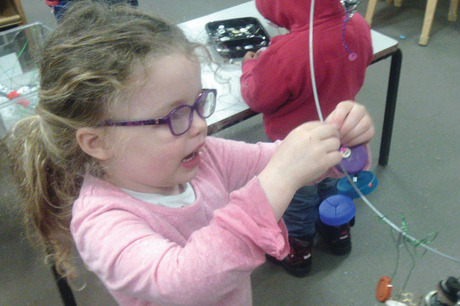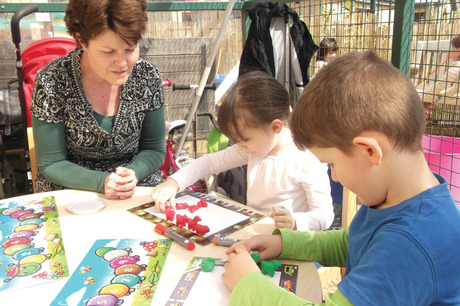
Our series on good EYPP practice has spanned a variety of interventions based on what practitioners have identified to be the areas of greatest need. But it is also worth bearing in mind that research has shown there is an overarching need for quality for any of these interventions to be truly effective.
‘Don’t spend EYPP funding on making the lavatories better or nice new toys – focus on developing staff, looking at language and behaviour, and understanding how children learn,’ says Professor Jacqueline Barnes, director of the Institute for the Study of Children, Families & Social Issues at Birkbeck, University of London. ‘In particular, quality will be enhanced through a focus on communication and language, and self-regulation in children.’
Interactions involving sustained shared thinking, where adults and children work together in an intellectual way to solve a problem or clarify a concept, are particularly effective in developing critical thinking and extending learning. ‘It is about sustaining dialogue and talking in a more engaging and stimulating way,’ says Professor Barnes. ‘Staff can be trained quite easily in that approach.’
The Sustained Shared Thinking and Emotional Wellbeing (SSTEW) scale can help settings and practitioners improve the quality of their work across five areas: building trust, confidence and independence; social and emotional well-being; supporting and extending language and communication; supporting learning and critical thinking; and assessing learning and language. Iram Siraj, professor of early childhood education at the Institute of Education, University College London, is one of the SSTEW authors. She says: ‘Our research has found settings are quite weak overall at supporting and extending language and communication, supporting critical thinking and extending children’s vocabulary. Sustained shared thinking is a significant weakness in many settings – practitioners tend to get into crowd control, organising groups at story time or home time, and losing the sense of children as individuals who want to learn.’
Professor Siraj is also author of the Early Childhood Environment Rating Scale extension, and based on research in the UK and Australia has found that maths, science and diversity (for example, planning for individual learning needs, valuing and respecting other cultures, or gender diversity) are areas of particular weakness in many settings.
An investment in staff training in these areas can create a higher-quality learning environment and boost outcomes. Seven settings in the London borough of Newham, for example, pooled EYPP funding to host a conference focusing on sustained shared thinking and quality interactions with children. ‘All our staff came, a couple of governors, and our childminder co-ordinator – it was a very powerful day and a really good use of funds,’ says Ann Collier, headteacher at Edith Kerrison Nursery, where around 20 per cent of children are EYPP-eligible. ‘It made the staff even more aware of how important it is to involve children in conversations as much as possible, even when children have limited English,’ she adds. ‘It is hard to spend the EYPP funding directly on specific children because they are identified so late, so it makes more sense to improve the quality of the setting.’
Pembury House Nursery School in Haringey chose to spend part of its EYPP funding on developing sustained shared thinking and problem-solving. The setting pays for resident artist Cath Rive to come in once a week, with projects including work around photography and an exploration of reflective materials.

‘It’s really about nurturing their curiosity and following their interests and ideas,’ says Ms Rive. ‘When we decided to design and create something for the wall outside the nursery, for example, we started off by asking how will we make it? What will it look like? The children wanted the piece to be sparkly and glittery, and circles were very significant to them, so the piece became about woodwork, fixing buttons and beads onto log circles.’
While Ms Rive works with a core group of EYPP-eligible children, others are free to join in. ‘Because Cath has a member of staff working with her, when she is not there that practitioner can extend what she is doing and give more opportunities for critical thinking around that topic,’ says Sue Moss, headteacher at Pembury. The setting uses a version of the Mindstretchers Talking and Thinking Floorbooks (www.mindstretchers.co.uk), which record what children are doing and saying, theoretically allowing children’s voices to be heard in planning. Staff also track the impact of the EYPP spend using an online learning journal.
CASE STUDY: FAMILY ACTION

Paula Wright, a qualified early years professional, is employed by charity Family Action to plan and deliver interventions for EYPP-eligible children across five settings in Peterborough: St Michael’s Ark, Paston Fundays, Paston Playdays, Cygnets and Woodfield Park. The funding from all five settings is used to pay for her salary, with anything left over spent on new resources, although Ms Wright creates a lot of her own, such as strips of material to use in comparing lengths.
‘The number of eligible children and thus the funding is fluctuating all the time, but the value Paula has brought has been so great that even if there is a shortfall we will make it up,’ says early years manager Karen Hornsby. ‘A lot of people are taking the route of spending on resources or experiences, and we felt that while that can work, we prefer to make a more effective use of it.’
Ms Wright (pictured) works directly with EYPP-eligible children, many of whom do not have English as a first language, both individually and in groups. Her presence also helps the settings as a whole to develop a quality learning environment. ‘Staff can go to Paula about a particular child, and she can advise them on strategies and activities,’ says Ms Hornsby. ‘There is a training element raising the quality of the environment, with other practitioners observing or coming and joining in with her from time to time.’
‘Practitioners have asked to observe me and see how I was engaging with children, listening carefully to the language I use with them,’ says Ms Wright. ‘Language use is an important aspect of my role and helps to gain their trust. The staff are also interested in the resources I use, and work to duplicate them so other children can benefit.’
Ms Wright draws on the practice of sustained shared thinking to support and extend children’s development and learning. ‘If we are talking about floating and sinking, for example, for some children that is about the difference between the two, while others want to know more – why some things float,’ she says.
She shares her plans and observations with the settings. ‘Paula keeps detailed observations and shares with the key workers so they have got a really good evidence base, and I can see the progress those children are making,’ says Ms Hornsby. ‘You can see the majority of the early years outcomes are now in the 40/60 bracket, where previously they were lower.’
‘The most rewarding aspect is the increase in confidence,’ says Ms Wright. ‘Some children didn’t seem to believe they could learn anything, but when I walk into the setting now, children come and ask what we are doing today.’
Further reading
Education Endowment Foundation toolkit, http://bit.ly/24fgggQ
Professor Jacqueline Barnes’ presentation on evidence and the most effective ways to spend the EYPP, http://bit.ly/1VU6Llp
Early Education evaluation of EYPP, http://bit.ly/1TsIqjc
Assessing Quality in Early Childhood Education and Care: Sustained Shared Thinking and Emotional Well-being (SSTEW) Scale for 2–5-Year-Olds Provision by Iram Siraj, http://bit.ly/1Nt3x5E









